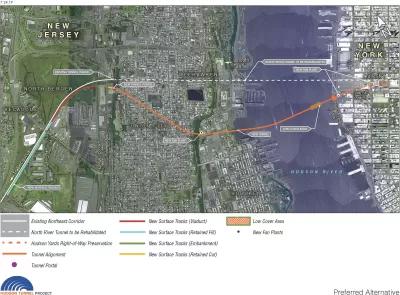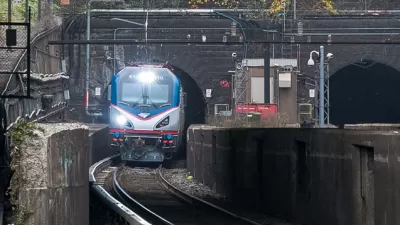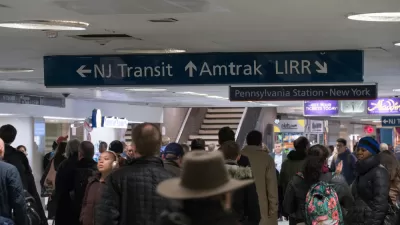The $6.8 billion federal grant will fund the construction of a new tunnel at a key crossing under the Hudson River to supplement and replace tunnels damaged in Hurricane Sandy.

The new Gateway tunnel linking Manhattan and New Jersey received a boost this week in the form of federal funding that will contribute roughly $6.88 billion to the project’s estimated $16 billion total, writes Patrick McGeehan in The New York Times.
“The two-tube tunnel is part of Gateway, a massive infrastructure project that is widely considered the most important in the country. The new tunnel would supplement a troublesome pair of single-track tunnels that opened in 1910 and have been steadily deteriorating since Hurricane Sandy flooded them with salt water in 2012.”
Once the new tunnel is operational, Amtrak plans to close the existing tunnels to repair damage from Hurricane Sandy. “If one of the existing tracks had to be closed before the new tunnel is available, train capacity between Penn Station and places west of the Hudson would be cut by 75 percent during rush hours, according to Amtrak,” which would have a major impact on regional mobility and economic activity.
Unlike previous New York-to-New Jersey tunnel projects, the new tunnel has support from officials at all levels of government.
FULL STORY: Hudson Tunnel Project to Get $6.9 Billion in Largest U.S. Transit Grant

Trump Administration Could Effectively End Housing Voucher Program
Federal officials are eyeing major cuts to the Section 8 program that helps millions of low-income households pay rent.

Planetizen Federal Action Tracker
A weekly monitor of how Trump’s orders and actions are impacting planners and planning in America.

Ken Jennings Launches Transit Web Series
The Jeopardy champ wants you to ride public transit.

California Invests Additional $5M in Electric School Buses
The state wants to electrify all of its school bus fleets by 2035.

Austin Launches $2M Homelessness Prevention Fund
A new grant program from the city’s Homeless Strategy Office will fund rental assistance and supportive services.

Alabama School Forestry Initiative Brings Trees to Schoolyards
Trees can improve physical and mental health for students and commnity members.
Urban Design for Planners 1: Software Tools
This six-course series explores essential urban design concepts using open source software and equips planners with the tools they need to participate fully in the urban design process.
Planning for Universal Design
Learn the tools for implementing Universal Design in planning regulations.
Ada County Highway District
Clanton & Associates, Inc.
Jessamine County Fiscal Court
Institute for Housing and Urban Development Studies (IHS)
City of Grandview
Harvard GSD Executive Education
Toledo-Lucas County Plan Commissions
Salt Lake City
NYU Wagner Graduate School of Public Service





























